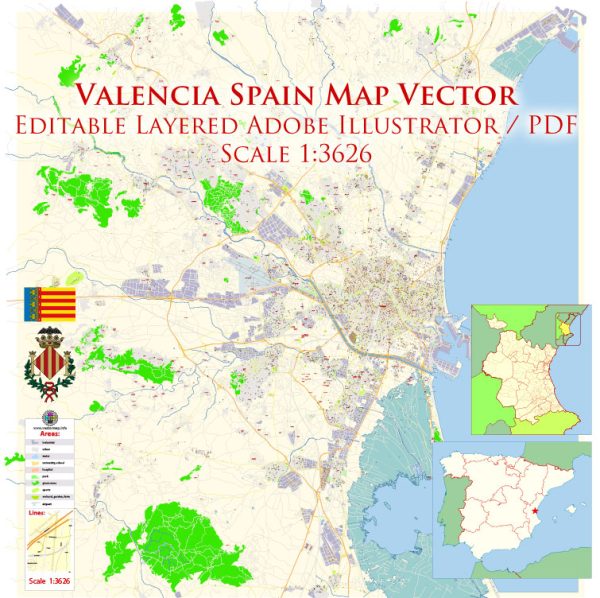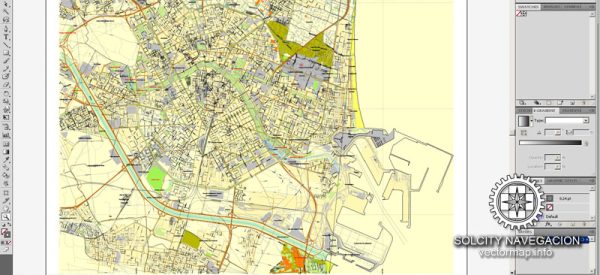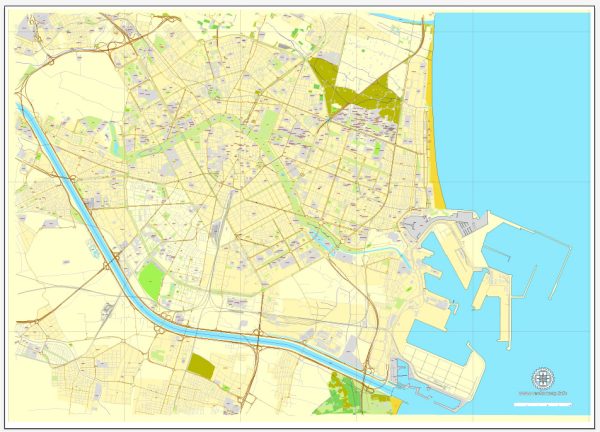Valencia, located on the eastern coast of Spain, is a city rich in history and culture.
Vectormap.Net provide you with the most accurate and up-to-date vector maps in Adobe Illustrator, PDF and other formats, designed for editing and printing. Please read the vector map descriptions carefully.
Here’s a detailed description of some of the historic places, buildings, streets, and squares that make Valencia a unique and fascinating destination:
- Valencia Cathedral (Catedral de Valencia):
- This iconic cathedral is a masterpiece of Gothic, Baroque, and Romanesque architecture.
- The Holy Grail, believed to be the cup used by Jesus at the Last Supper, is housed in the cathedral.
- The Miguelete Tower offers panoramic views of the city.
- La Lonja de la Seda (Silk Exchange):
- A UNESCO World Heritage Site, La Lonja is a stunning example of late Gothic civil architecture.
- Built in the 15th century, it was a hub for silk trading during Valencia’s golden age.
- Torres de Serranos and Torres de Quart:
- These medieval towers were part of the city’s defensive walls.
- Both serve as excellent examples of Valencian Gothic military architecture.
- Plaza de la Virgen:
- A picturesque square surrounded by historic buildings, including the Valencia Cathedral and the Basilica de la Virgen de los Desamparados.
- The Turia Fountain is a focal point of the square, representing the Turia River.
- City of Arts and Sciences (Ciudad de las Artes y las Ciencias):
- Although more modern, this architectural complex is a must-visit.
- Designed by Santiago Calatrava and Félix Candela, it includes the Hemisférico, the Science Museum, the Palau de les Arts Reina Sofia, and the Agora.
- Mercado Central:
- A bustling market, Mercado Central is a beautiful example of Valencian Art Nouveau architecture.
- It is one of the oldest running food markets in Europe, offering fresh produce, meats, and local delicacies.
- Plaza de la Reina:
- A central square in Valencia surrounded by historical buildings, including the Valencia Cathedral.
- It is a vibrant area with restaurants, shops, and street performers.
- Barrio del Carmen:
- This historic neighborhood is known for its narrow streets, medieval buildings, and vibrant nightlife.
- It’s a great place to explore the city’s bohemian side, with plenty of cafes, bars, and street art.
- Palacio del Marqués de Dos Aguas:
- An ornate Rococo palace that now houses the National Ceramics Museum.
- The exterior is adorned with intricate sculptures and decorations.
- Plaza del Ayuntamiento:
- Valencia’s main square, surrounded by important buildings like the City Hall, Post Office, and the Plaza de Toros (bullring).
- A central location for events, festivals, and celebrations.
Exploring Valencia’s historic sites provides a captivating journey through different periods of Spanish history and architectural styles. The city seamlessly blends its rich past with modern developments, making it a dynamic and appealing destination.




 Author: Kirill Shrayber, Ph.D.
Author: Kirill Shrayber, Ph.D.